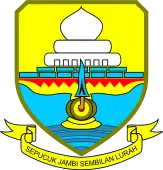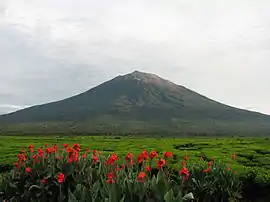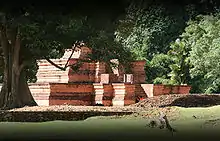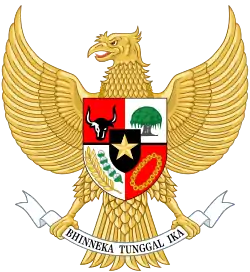Jambi
Jambi is a province of Indonesia. It is located on the east coast of central Sumatra and spans to the Barisan Mountains in the west. Its capital and largest city is Jambi. The province has a land area of 50,160.05 km2, and a sea area of 3,274.95 km2. It had a population of 3,092,265 according to the 2010 Census[4] and 3,397,164 according to the 2015 Census.[5] The latest estimate (for mid 2019) is 3,566,197.[6]
Jambi | |
|---|---|
 Flag  Coat of arms | |
 Location of Jambi in Indonesia | |
| Coordinates: 1°35′S 103°37′E | |
| Established | 6 January 1957 |
| Capital and largest city | Jambi |
| Government | |
| • Body | Jambi Provincial Government |
| • Governor | Fachrori Umar |
| • Vice Governor | Vacant |
| Area | |
| • Total | 50,160.05 km2 (19,366.90 sq mi) |
| Area rank | 11th |
| Elevation | 500 m (1,600 ft) |
| Highest elevation | 3,805 m (12,484 ft) |
| Lowest elevation | 0 m (0 ft) |
| Population (2019)[1] | |
| • Total | 3,566,197 |
| • Rank | 19th |
| • Density | 71/km2 (180/sq mi) |
| • Density rank | 23rd |
| Demographics | |
| • Ethnic groups | 38% Malay 20% Javanese 10.2% Chinese 10% Kerinci 5.2% Minangkabau 3.4% Batak 13.4% other[2] |
| • Religion | 95% Islam 3.1% Christianity 0.9% Buddhism 1% other |
| • Languages | Indonesian (official) Jambi Malay, Kerinci, Kubu (regional) |
| HDI | |
| HDI rank | 18th in Indonesia (2019) |
| GRP Nominal | |
| GDP PPP (2019) | |
| GDP rank | 15th in Indonesia (2019) |
| Nominal per capita | US$ 4,248 (2019)[3] |
| PPP per capita | US$ 13,963 (2019)[3] |
| Per capita rank | 7th in Indonesia (2019) |
| Website | jambiprov |
History

Jambi was the site of the Srivijayan kingdom that engaged in trade throughout the Strait of Malacca and beyond. Jambi succeeded Palembang, its southern economic and military rival, as the capital of the kingdom. The movement of the capital to Jambi was partly induced by the 1025 raid by pirates from the Chola region of southern India, which destroyed much of Palembang.
In the early decades of the Dutch presence in the region (see Dutch East India Company in Indonesia), when the Dutch were one of several traders competing with the British, Chinese, Arabs, and Malays, the Jambi Sultanate profited from trade in pepper with the Dutch. This relationship declined by about 1770, and the sultanate had little contact with the Dutch for about sixty years.
In 1833, minor conflicts with the Dutch (the Indonesian colonial possessions of which were now nationalised as the Dutch East Indies) who were well established in Palembang, meant the Dutch increasingly felt the need to control the actions of Jambi. They coerced Sultan Facharudin to agree to greater Dutch presence in the region and control over trade, although the sultanate remained nominally independent. In 1858 the Dutch, apparently concerned over the risk of competition for control from other foreign powers, invaded Jambi with a force from their capital Batavia. They met little resistance, and Sultan Taha fled upriver, to the inland regions of Jambi. The Dutch installed a puppet ruler, Nazarudin, in the lower region, which included the capital city. For the next forty years Taha maintained the upriver kingdom, and slowly reextended his influence over the lower regions through political agreements and marriage connections. In 1904, however, the Dutch were stronger and, as a part of a larger campaign to consolidate control over the entire archipelago, soldiers finally managed to capture and kill Taha, and in 1906, the entire area was brought under direct colonial management.
Following the death of Jambi sultan, Taha Saifuddin, on 27 April 1904 and the success of the Dutch controlled areas of the Sultanate of Jambi, Jambi then set as the Residency and entry into the territory Nederlandsch Indie. Jambi's first Resident OL Helfrich was appointed by the Governor General under Dutch Decree No. 20, dated 4 May 1906 with his inauguration held on 2 July 1906.
| Year | Pop. | ±% |
|---|---|---|
| 1971 | 1,006,084 | — |
| 1980 | 1,445,994 | +43.7% |
| 1990 | 2,020,568 | +39.7% |
| 1995 | 2,369,959 | +17.3% |
| 2000 | 2,407,166 | +1.6% |
| 2005 | 2,635,968 | +9.5% |
| 2010 | 3,092,265 | +17.3% |
| 2015 | 3,397,164 | +9.9% |
| 2017 | 3,515,017 | +3.5% |
| 2019 | 3,566,197 | +1.5% |
| Source: Badan Pusat Statistik 2014 | ||
Administrative divisions
Jambi province is divided into nine regencies (kabupaten) and two cities (kota), listed below with their areas and their populations at the 2010 and 2015 Censuses and according to the latest (2019) estimates. These are divided into 141 districts (kecamatan), in turn sub-divided into 153 urban villages (kelurahan) and 1,399 rural villages (desa).
| Name | Area (km2) | Population Census 2010 | Population Census 2015 | Population Estimate 2019 | Capital | HDI[7] 2018 Estimates |
|---|---|---|---|---|---|---|
| Jambi City | 205.43 | 531,857 | 575,388 | 594,942 | - | 0.774 (High) |
| Sungai Penuh City | 391.50 | 82,293 | 87,032 | 88,321 | - | 0.746 (High) |
| Batanghari Regency | 5,804.00 | 241,334 | 260,290 | 268,458 | Muara Bulian | 0.693 (Medium) |
| Bungo Regency | 4,659 | 303,135 | 343,489 | 368,993 | Muara Bungo | 0.694 (Medium) |
| East Tanjung Jabung Regency (Tanjung Jabung Timur) | 5,445.00 | 205,272 | 213,536 | 213,981 | Muara Sabak | 0.633 (Medium) |
| Kerinci Regency | 3,355.27 | 229,495 | 234,912 | 237,458 | Siulak | 0.705 (High) |
| Merangin Regency | 7,679.00 | 333,206 | 365,763 | 382,762 | Bangko | 0.688 (Medium) |
| Muaro Jambi Regency | 5,326.00 | 342,952 | 398,196 | 436,453 | Sengeti | 0.683 (Medium) |
| Sarolangun Regency | 6,184.00 | 246,245 | 277,733 | 297,214 | Sarolangun | 0.694 (Medium) |
| Tebo Regency | 6,461.00 | 297,735 | 330,403 | 348,877 | Muara Tebo | 0.686 (Medium) |
| West Tanjung Jabung Regency (Tanjung Jabung Barat) | 4,649.85 | 278,741 | 310,422 | 328,738 | Kuala Tungkal | 0.671 (Medium) |
| Total province | 50,160.05 | 3,092,265 | 3,397,164 | 3,566,197 | Jambi | 0.705 (High) |
World Heritage sites


The largest of the three national parks comprising the Tropical Rainforest Heritage of Sumatra, Kerinci Seblat has the distinction of being the second-largest national park in all of Southeast Asia, only after Lorentz National Park on Papua. It is one of the Sumatran Tiger's last strongholds on the island, and within its borders sits the highest active volcano in Southeast Asia - Mount Kerinci.
May 2011: The Jambi provincial administration is striving to have the ancient Muaro Jambi temple site at Muaro Jambi village in Maro Sebo District, Muaro Jambi Regency, recognized as a world heritage site.
The site was a Buddhist education centre that flourished during the 7th and 8th centuries and is made from bricks similar to those used in Buddhist temples in India.[8]
Demographics
The official language of Jambi province is Indonesian as in all parts of Indonesia. However Jambi is also home to several indigenous languages and dialects such as Jambi Malay, Kerinci language, Kubu language, Lempur Malay, and Rantau Panjang Malay, all of which are Malayan languages.[9]
Due to transmigration policy, many ethnic groups from various parts of Indonesia, especially Java, Borneo, Sulawesi and other parts of Sumatra brought their native languages as well. The non-Pribumi people such as the Chinese Indonesians speak several varieties of Chinese.
Ethnically, the population comprises:
- 38% Malay
- 20% Javanese
- 10.2% Chinese
- 10% Kerinci
- 5.2% Minangkabau
- 3.4% Batak
- 3.3% Banjarese
- 3.1% Buginese
- 2.6% Sundanese, and
- 4.4% other[10]
Islam is the largest religion in Jambi, being practised by 96.5% of the population. Minority religions are Christianity with 3%, Buddhism 0.97%, Confucianism 0.05% and Hinduism 0.25% of the population.[11]
See also
- Putri Tangguk, a Malay traditional folklore originated from Jambi
References
- Badan Pusat Statistik, Jakarta, 2019.
- . Badan Pusat Statistik. 2010. Missing or empty
|title=(help) - "Indonesia". Badan Pusat Statistik. Retrieved 20 May 2020.
- (2010 BPS)
- Badan Pusat Statistik, Jakarta, 2019.
- Badan Pusat Statistik, Jakarta, 2019.
- "Waspada Online – Pusat Berita dan Informasi Medan Sumut Aceh". waspada.co.id. Retrieved 22 March 2018.
- "Archived copy" (PDF). Archived from the original (PDF) on 2014-07-14. Retrieved 2014-07-02.CS1 maint: archived copy as title (link)
- . Badan Pusat Statistik. 2010. Missing or empty
|title=(help) - "Penduduk Menurut Wilayah dan Agama yang Dianut". sp2010.bps.go.id. Retrieved 2018-02-25.
- Locher-Scholten, Elsbeth. 1993. Rivals and rituals in Jambi, South Sumatra. Modern Asian Studies 27(3):573-591.
External links
- (in Indonesian) Official government site
- (in Indonesian) Fan site
